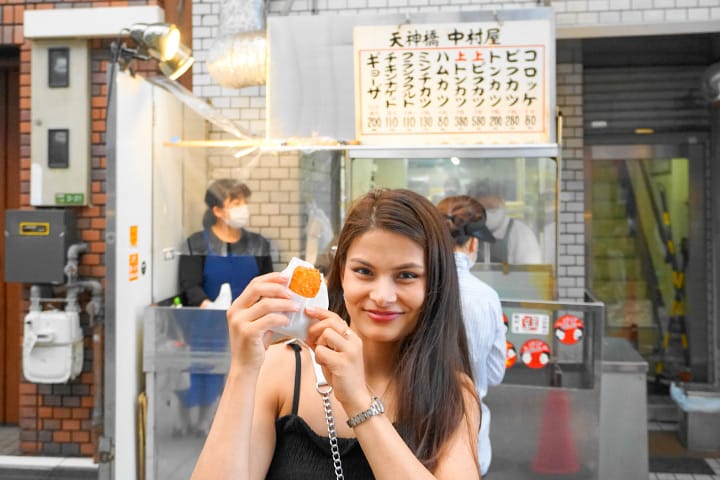Osaka has a serious nickname: Japan’s Kitchen. Walk through a few of the big markets and you will understand why in about five minutes. Steam, sizzling grills, mountains of seafood, and the smell of fresh dashi all blend together. For food lovers, exploring Osaka food markets is just as important as visiting Osaka Castle or Dotonbori.
This 2025 guide walks you through the best Osaka food markets, what to eat at each one, how to get there, and a few secret spots locals love. It is written for travelers who want clear, practical help, not just pretty photos. Grab a snack before you start reading. You will get hungry.

What To Know Before You Visit Osaka Food Markets
Before we dive into specific markets, here are a few basics that apply almost everywhere.
Cash, cards and payment
Most stalls still prefer cash, although more shops accept IC cards and credit cards every year. For small bites like skewers or snacks, assume you will pay in coins or notes. ATMs are easy to find in convenience stores near the main Osaka food markets, so withdraw a bit before you go.
When markets are open
Many markets open by 9:00 in the morning and start winding down around 5:00 in the afternoon. Some street food areas stay lively until late at night. For the freshest seafood, visit early. For atmosphere and crowds, late morning to mid afternoon works best. Mondays can be quiet because some wholesalers take that day off.
Eating while walking
In Japan the rule is usually “do not walk and eat.” Markets are a little more relaxed, but it is still polite to stand to the side or use a small counter if one is provided. When in doubt, watch what locals do and follow their lead.
Trash and recycling
You will not see many public trash cans. Most stalls will take your skewers, cups or plates back when you finish. Hand them back with a small bow and a “thank you.”
Language
Basic English is common around the big Osaka food markets, especially Kuromon. Most stalls display prices and photos, so pointing at what you want works fine. Learning simple words like “kore onegaishimasu” (this one please) makes the experience smoother.

The Best Osaka Food Markets For 2025
1. Kuromon Ichiba Market: Osaka’s Kitchen In One Street
If you visit only one of the Osaka food markets, make it Kuromon Ichiba. This covered market near Namba has fed Osaka for more than a hundred years. Locals still shop here for fish and vegetables, but it is also a paradise for visitors who want to snack their way down a single street.
Where it is
Kuromon sits a short walk east of Nippombashi Station and about ten to fifteen minutes on foot from Namba. The market is one long arcade, so it is very easy to navigate.
Best time to visit
Come between 10:00 and 13:00 for the full buzz, when tour groups, office workers and shoppers all mix together. By late afternoon a lot of fresh seafood starts to sell out.
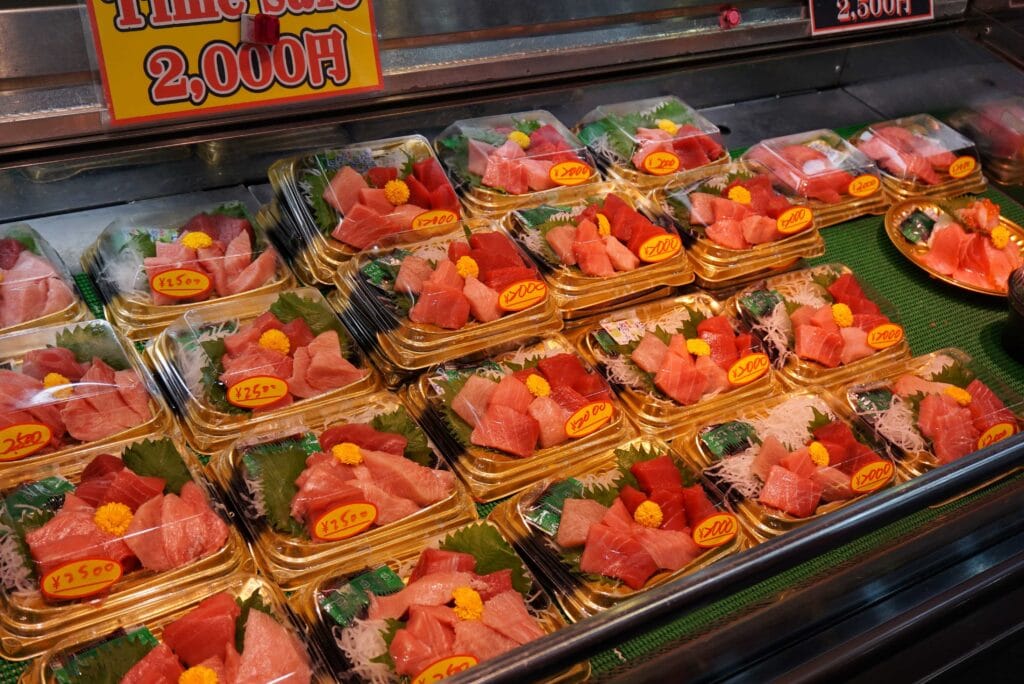
What to eat at Kuromon
You could easily spend half a day here just tasting.
- Fresh oysters grilled to order with butter or soy
- Uni (sea urchin) served in small trays or on top of rice bowls
- Toro and salmon sashimi, sometimes skewered for easier eating
- Wagyu beef cubes, seared on a hot plate then sprinkled with salt
- Grilled scallops and jumbo prawns
- Takoyaki, Osaka’s famous octopus balls, often filled with extra cheese or toppings
- Deep fried croquettes and katsu made from crab or beef
- Fresh fruit on sticks, like perfect strawberries and large slices of melon
If you want a proper sit down meal, look for small counters serving kaisen don, which are rice bowls topped with assorted raw fish. They are filling, fresh and still cheaper than sushi in many other cities.
Tips for Kuromon
Prices can vary a lot between stalls. Walking the full length of the market first is a smart move. You will see which places are busy with Japanese customers. That is where you want to eat.
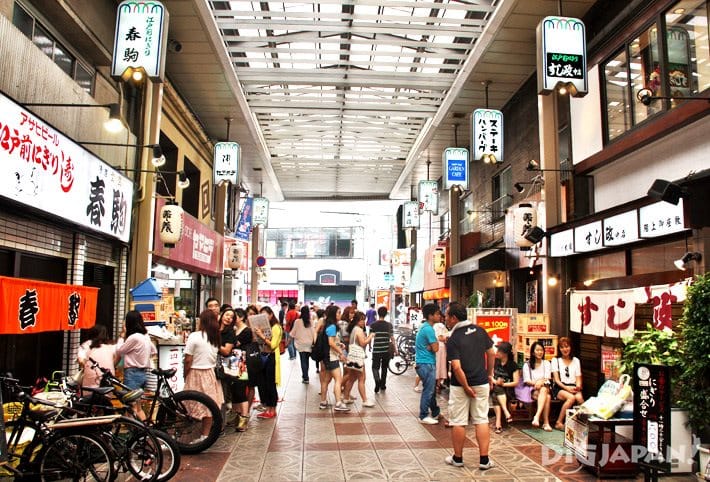
2. Tenjinbashisuji Shopping Street: The Local Giant
Tenjinbashisuji Shotengai is not only one of the key Osaka food markets. It is also said to be the longest covered shopping street in Japan, stretching about 2.6 kilometers. Unlike tourist heavy areas, this arcade feels very local. You will see grandparents shopping for dinner, kids stopping for snacks, and salary workers grabbing quick lunches.
Where it is
The street runs north of Osaka Station, between Tenjimbashisuji Rokuchome and Minamimorimachi stations. You can enter from several subway stops along the line.
Why visit
Tenjinbashisuji is less about flashy seafood and more about everyday Osaka food culture. Small okonomiyaki joints sit next to croquette stalls, tofu shops, tea stores and old school kissaten coffee houses.
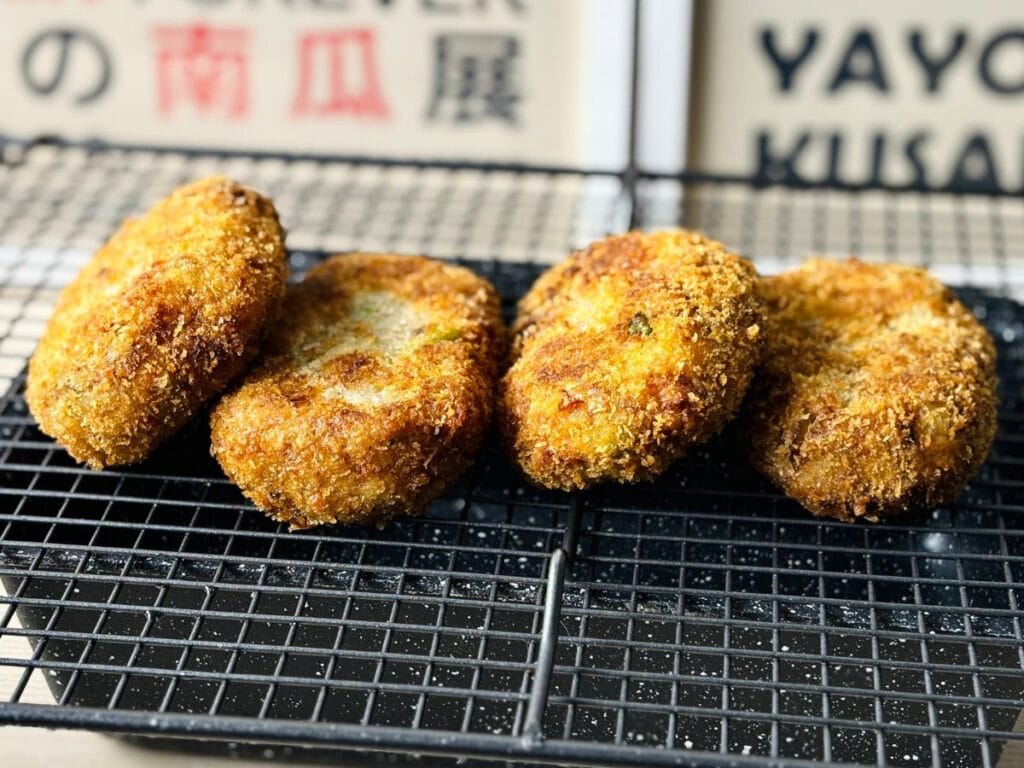
xr:d:DAF6oKnfde4:5,j:1622838069269239840,t:24012216
What to eat
- Cheap and crispy korokke from tiny butcher shops
- Taiyaki filled with red bean paste, custard or chocolate
- Okonomiyaki cooked on a steel plate right in front of you
- Handmade udon or soba in small noodle shops
- Seasonal sweets from wagashi stores
Because it is so long, pick a section and wander slowly. This is a great place to see daily life and escape the tour bus crowds at the more famous Osaka food markets.
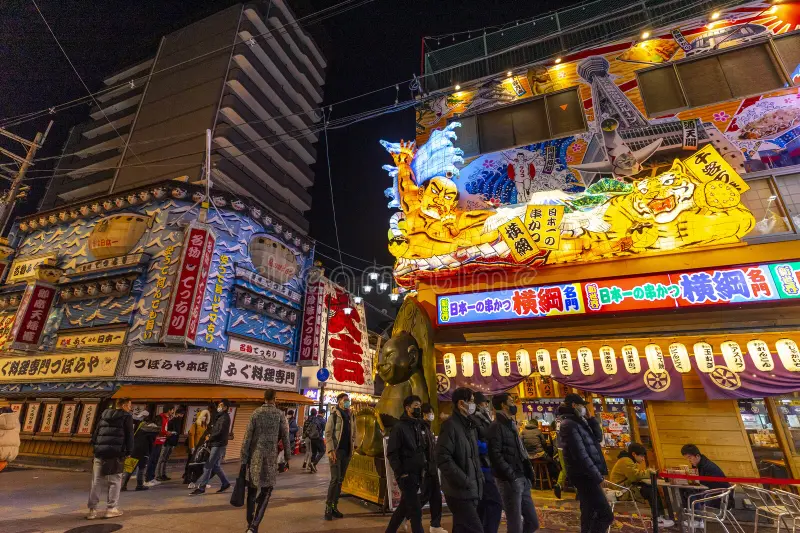
3. Shinsekai and Janjan Yokocho: Retro Street Food Zone
Shinsekai looks like it has stepped straight out of a past era, complete with neon signs, old style game centers and the Tsutenkaku Tower watching over everything. The narrow alley of Janjan Yokocho that runs through it is a dream for fans of fried food and cheap drinks.
Where it is
You can reach Shinsekai from Dobutsuen-mae Station or Ebisucho Station. The area is very walkable, with restaurants squeezed on both sides of each alley.
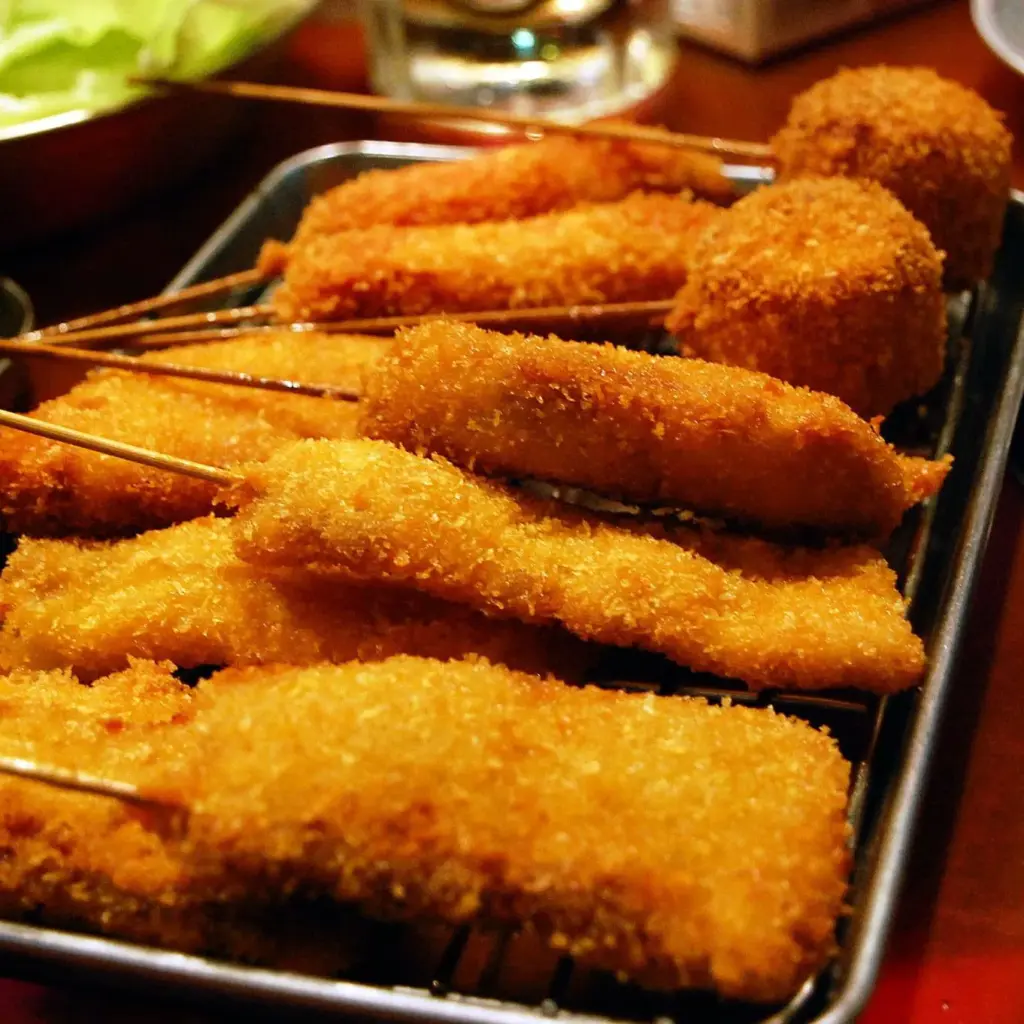
Signature food: Kushikatsu
Kushikatsu is king here. These are skewers of meat, vegetables or seafood coated in panko and fried to a crisp. You dip them into a shared metal pot of sauce, but only once. Double dipping is the one big rule.
Other popular snacks include doteyaki, which is slow cooked beef tendon in miso sauce, oden in winter, and cheap draft beer or highballs.
Compared with other Osaka food markets, Shinsekai feels more rough around the edges but very friendly. It is lively from lunchtime until late at night.
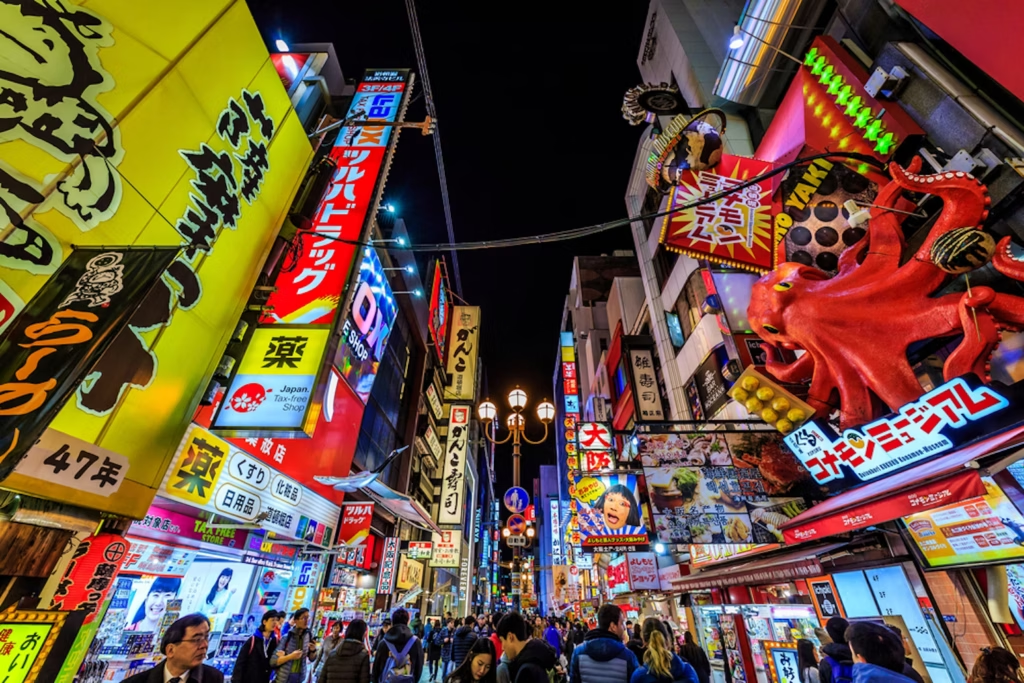
4. Dotonbori and Namba: The Famous Neon Food Strip
Dotonbori is not a market in the traditional sense, but it is impossible to write about Osaka food markets without mentioning this strip along the canal. Giant moving signs of crabs, gyoza and puffer fish hang above the street. At night everything lights up and the area turns into a food carnival.
Where it is
The main street runs along the Dotonbori canal near Namba Station and Shinsaibashi Station. You cannot miss it.

What to eat in Dotonbori
- Takoyaki from one of the many famous chains like Kukuru
- Okonomiyaki thick with cabbage, pork and sauce
- Gyoza with crispy bottoms and juicy fillings
- Ramen in all styles, including rich tonkotsu and lighter shoyu
- Crab dishes at big seafood restaurants if you want to splurge
Because it is so central, many travelers base themselves near Namba and then sample other Osaka food markets as day trips. Dotonbori is hyper touristy, but it is also fun and full of energy.

5. Osaka Central Fish Market: For Serious Seafood Fans
If you enjoy early mornings and fish auctions, Osaka Central Wholesale Market is worth the effort. It is one of the largest fish markets in western Japan. Tours are sometimes available, but even without a tour you can visit the area around the market and eat at small restaurants that serve ultra fresh seafood.
Highlight: Endo Sushi
The most famous spot near the market is Endo Sushi. It has been serving a special style of sushi with warm rice for more than a century. Diners usually order a set plate of five pieces chosen by the chef. You sit at a small counter, watch the fish being sliced, and eat as soon as it is placed in front of you.
Practical notes
The market area is a little out of the way, near Tamagawa Station or Noda. Try to arrive early in the morning since many stalls and restaurants close by early afternoon. This is not one of the first Osaka food markets most people visit, but for sushi lovers it can be the most memorable.
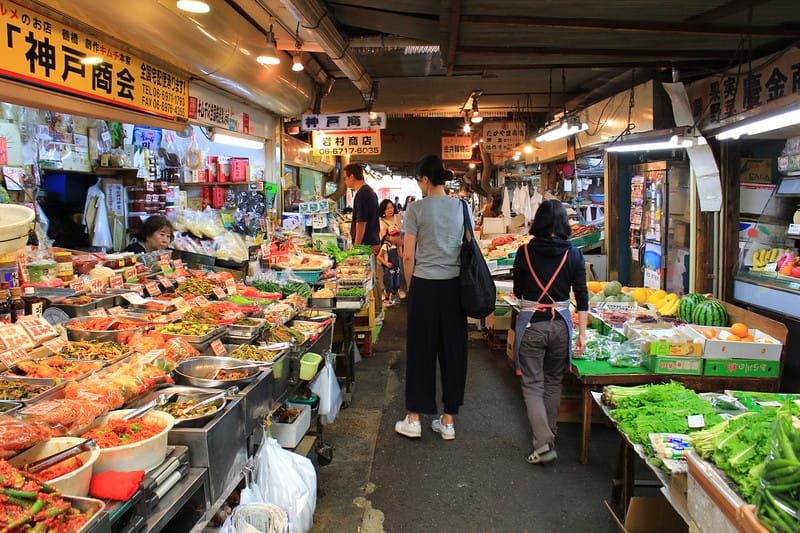
6. Tsuruhashi Korea Town: Spicy Street Food And Barbecue
Osaka has long had a strong Korean community. In Tsuruhashi, southeast of the city center, you can walk through covered alleys packed with butchers, kimchi shops and restaurants focused on Korean flavors.
Where it is
Tsuruhashi Station is served by the JR Loop Line, the Kintetsu Line and the subway. Once you exit, follow signs to the market and Korea Town.
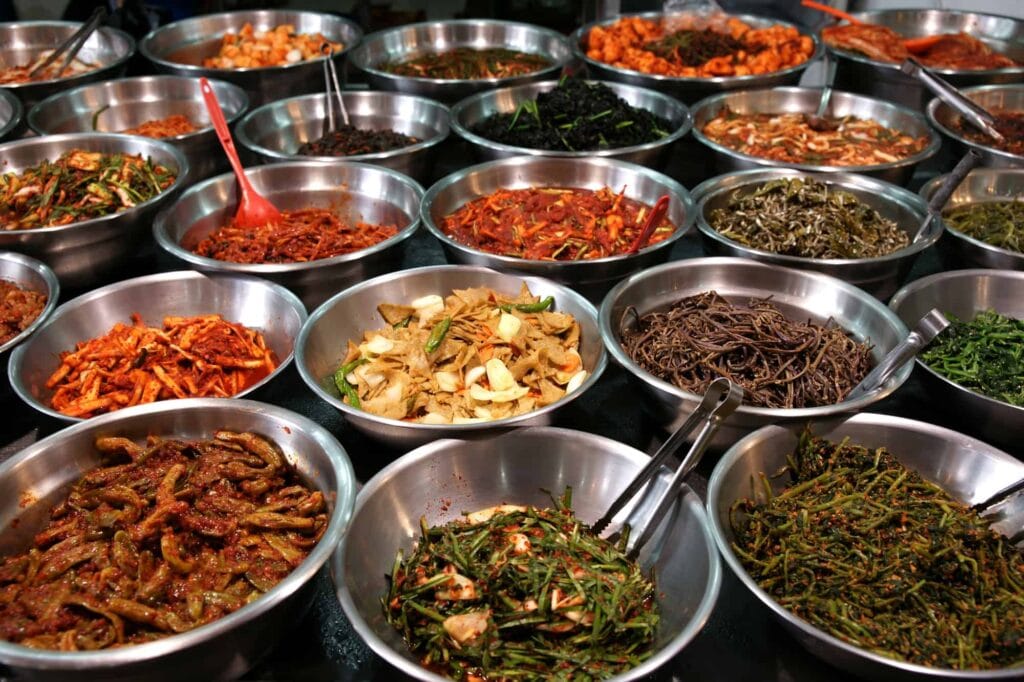
What to eat
- Korean barbecue with thin sliced beef or pork grilled at your table
- Hotteok, which are sweet pancakes filled with brown sugar and nuts
- Tteokbokki, chewy rice cakes in spicy sauce
- Kimchi in many varieties, from mild to very strong
- Korean fried chicken with sticky sauces
Tsuruhashi is a great change of pace from Japanese food heavy Osaka food markets. It works well for dinner, when the grills fire up and the smell of garlic and sesame fills the air.
7. Umeda and Namba Depachika: Basement Food Halls
In Japan, department store basements are food heaven. These depachika floors feel like indoor markets. Counters display bento boxes, fried foods, salads, cakes, sweets, bread and high end gifts.
In Osaka the best depachika are in the big department stores around Umeda and Namba, such as Hankyu, Hanshin, Daimaru and Takashimaya.
Why depachika belong in an Osaka food markets guide
- Huge variety in a compact, orderly space
- Easy way to sample many dishes in one visit
- Perfect for taking out food to eat at your hotel or at a nearby park
- Many seasonal items and limited time sweets
Popular picks include tempura assortments, katsu sandwiches, beautifully packed sushi trays, fruit tarts and regional sweets that make great souvenirs. Go around late afternoon for discount stickers on boxes that need to be sold before closing.
8. Secret Food Market Spots Locals Love
The major Osaka food markets draw most of the attention, but a few smaller areas also deserve a place in your 2025 itinerary.
Sennichimae Doguyasuji
This covered street behind Namba is famous for kitchenware. You can buy takoyaki pans, knives, plastic food models and restaurant supplies. Hidden among these stores are small snack stands and cafes. It is less of a food market and more of a food lover’s shopping street, but it fits well into any day spent around Namba and Dotonbori.
Neighborhood shotengai
Osaka neighborhoods often have their own small shopping streets known as shotengai. They might not appear in guidebooks, but they offer an authentic look at daily life. If you stay in an Airbnb or smaller hotel, ask the host which local arcade they use for shopping. Early evenings are the best time to see salary workers and families buying side dishes to take home.
What To Eat At Osaka Food Markets: Must Try Dishes
No matter which Osaka food markets you visit, certain dishes appear again and again. Here is a simple checklist.
Takoyaki
Small round balls of batter filled with pieces of octopus, topped with sauce, mayo, dried bonito and seaweed. In Osaka they are everywhere, but markets like Kuromon and Dotonbori offer many versions, including cheese filled and extra crispy styles.
Okonomiyaki
A savory pancake made of shredded cabbage, flour, egg and meat or seafood. It is cooked on a hot plate, brushed with sauce, topped with mayo and bonito flakes, and sometimes served in slices for sharing. Some markets have small counters where you can watch it cook from start to finish.
Kushikatsu
Deep fried skewers of meat, fish, vegetables or tofu. The classic toppings are tonkatsu style brown sauce. Remember the no double dip rule if you share a sauce pot.
Fresh seafood
From simple grilled fish to fancy sashimi cups, seafood is a major reason people come to Osaka food markets. Look for:
- Oysters grilled or raw
- Uni served in wooden trays
- Crab legs, especially in winter
- Tuna, salmon and yellowtail sashimi
Market sweets
Food markets also cater to people with a sweet tooth. Try:
- Taiyaki shaped like fish, filled with red bean paste or custard
- Fruit sandwiches with whipped cream on fluffy white bread
- Soft serve ice cream made from fresh matcha or seasonal fruit
- Warabi mochi, a jelly like sweet covered in kinako soy powder
Planning Your Osaka Food Market Route
With so many choices it helps to group markets by area and time of day.
Day 1: Central and classic
- Morning at Kuromon Ichiba
- Walk to Dotonbori and Namba for lunch and street exploration
- Late afternoon in Doguyasuji for kitchenware browsing
Day 2: North side
- Start in Umeda depachika for breakfast snacks
- Move on to Tenjinbashisuji and wander as far as your feet allow
- Evening drinks and kushikatsu in Shinsekai
Day 3: Deep cuts for food fans
- Early start at Osaka Central Fish Market and Endo Sushi
- Afternoon rest
- Evening in Tsuruhashi Korea Town for barbecue
You do not need to follow this plan exactly. It simply shows how to link Osaka food markets in a logical way, without spending all day on trains.
Practical Tips For Enjoying Osaka Food Markets In 2025
- Bring a small reusable bag. Many stalls do not offer large bags, and you may want to carry snacks or souvenirs.
- Carry hand wipes. Street food can be messy, and sinks are not always nearby.
- Check current rules. Some markets now limit eating inside certain areas or ask visitors not to film staff faces. Signs in English are common, so read them.
- Stay aware of prices. Most stalls are fair, but high end seafood can add up. Confirm the price per piece or per plate before ordering.
- Be patient. Popular stalls often have lines. Waiting is normal and part of the experience.
Unique Things To Do After Exploring Osaka Food Markets
After hours of eating your way through Osaka food markets, you may want a fun, relaxing or unusual way to wrap up your day. Osaka has several experiences that fit perfectly after a big food adventure and help you enjoy the city in a totally different way.

Relax at an Onsen or Sento
Soaking in a hot bath is one of the best ways to unwind after walking and eating all day. Osaka has both onsens, which use natural hot spring water, and sentos, which are public bathhouses filled with heated water.
Spending time in an onsen can help your body relax and settle after a long day of tasting. The warm water helps your muscles recover and makes digestion feel easier. Many visitors say that an onsen session at night helps them sleep better and wake up ready for more exploring the next morning.
Some popular choices include:
- Large onsen complexes with indoor and outdoor baths
- Smaller local sentos that give you a real neighborhood feel
- Big spa facilities near major stations that offer saunas, lounges and massage chairs
Before entering, remember basic etiquette like washing your body first and keeping towels out of the water.

Try a Japanese Love Hotel for a Unique Overnight Stay
If you want something memorable and very Osaka, you can stay in one of the city’s love hotels. These hotels are famous for their themed rooms, bright lights and over the top designs. Many travelers book them simply for the experience, not for romance.
Love hotels are surprisingly clean, private and often cheaper than regular hotels. Rooms may include fun touches like neon lighting, giant bathtubs, karaoke systems, massage chairs or quirky decor. Staying in one can feel like stepping into a different world for a night.
They are also great for travelers who want a quiet space to rest after a long day of eating and exploring. Many are located around Namba, Umeda and Shinsekai, which means you can reach them quickly after visiting nearby Osaka food markets.
Stroll Through Dotonbori at Night
If you still have a little energy left, a slow walk through Dotonbori after dinner is one of the best ways to enjoy Osaka’s nightlife without more eating. The neon signs reflect off the canal and the whole area feels alive. Even if you ate everything you possibly could, watching the food stalls operate at night gives you a new perspective on how important food is to the city.
Enjoy a Rooftop View of Osaka
Another relaxing option is visiting one of Osaka’s observation decks. The quiet atmosphere, cool breeze and wide view can help you settle down after a heavy food day. The Umeda Sky Building and Abeno Harukas offer some of the best night views in Japan.
Visit a Themed Cafe or Pachinko Parlor
If you want something lighthearted, Osaka has themed cafes and retro arcades and pachinko parlors near several food markets. Playing a few simple games or sipping tea in a quirky cafe can help your stomach settle while you enjoy a bit more culture.
Osaka food markets are not just places to eat. They are where the city shows its true personality. You hear the dialect, watch the banter between stall owners and customers, and see how seriously locals take their food.
In 2025 the scene is more lively than ever, with new visitors discovering Kuromon, Tenjinbashisuji, Shinsekai and many other spots every day. Whether you are chasing the freshest sushi, searching for late night snacks in Dotonbori, or wandering through hidden shotengai, these markets will likely become the part of Osaka you remember most.
Plan a little, stay flexible, and arrive hungry.
